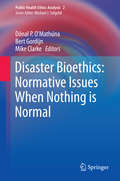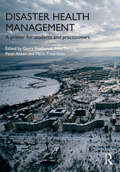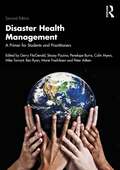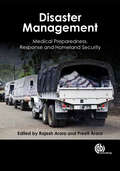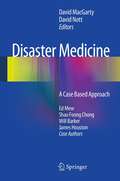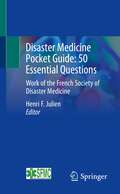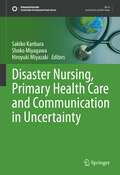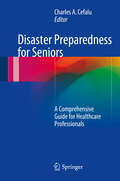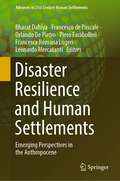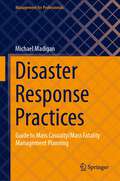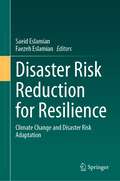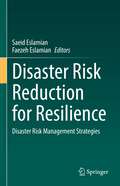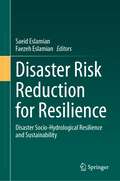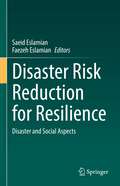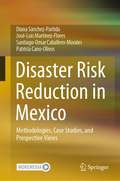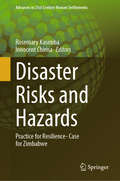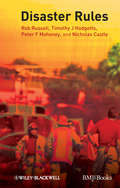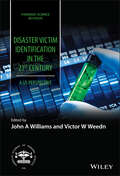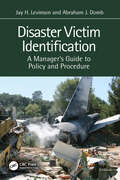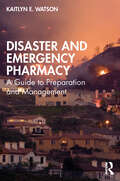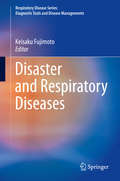- Table View
- List View
Disaster Bioethics: Normative Issues When Nothing is Normal
by Bert Gordijn Dónal P. O'Mathúna Mike ClarkeThis book provides an early exploration of the new field of disaster bioethics: examining the ethical issues raised by disasters. Healthcare ethics issues are addressed in the first part of this book. Large-scale casualties lead to decisions about who to treat and who to leave behind, cultural challenges, and communication ethics. The second part focuses on disaster research ethics. With the growing awareness of the need for evidence to guide disaster preparedness and response, more research is being conducted in disasters. Any research involving humans raises ethical questions and requires appropriate regulation and oversight. The authors explore how disaster research can take account of survivors? vulnerability, informed consent, the sudden onset of disasters, and other ethical issues. Both parts examine ethical challenges where seeking to do good, harm can be done. Faced with overwhelming needs and scarce resources, no good solution may be apparent. But choosing the less wrong option can have a high price. In addition, what might seem right at home may not be seen to be right elsewhere. This book provides in-depth and practical reflection on these and other challenging ethical questions arising during disasters. Scholars and practitioners who gathered at the Brocher Foundation in Geneva, Switzerland in 2011 offer their reflections to promote further dialogue so that those devastated by disasters are respected by being treated in the most ethically soun d ways possible.
Disaster Health Management: A Primer for Students and Practitioners
by Peter Aitken Gerry FitzGerald Mike Tarrant Marie FredriksenDisaster health is an emerging field that focuses on developing prevention, preparation, response and recovery systems for dealing with health problems that result from a disaster. As disasters worldwide differ in their nature, scope and cultural context, a thorough understanding of the fundamental tenets of sound disaster health management is essential for both students and practitioners to participate confidently and effectively in the field. Disaster Health Management is the first comprehensive textbook to provide a standard guide to terminology and management systems across the entire spectrum of disaster health. Authored by experienced educators, researchers and practitioners in disaster health management, this textbook provides an authoritative overview of: The conceptual basis for disaster management Systems and structures for disaster management Managing disasters through the continuum of preparedness, response and recovery The variations associated with both natural and technological disasters The strategic considerations associated with leadership, research, education and future directions. Using Australasian systems and structures as examples of generic principles which will find application globally, Disaster Health Management is an essential text for both undergraduate and postgraduate students, as well as for professionals involved in all aspects of disaster management.
Disaster Health Management: A Primer for Students and Practitioners
by Gerry FitzGeraldThe second edition of this leading textbook provides the definitive guide to disaster health management. From the key concepts, principles and terminology, to systems for mitigation, planning, response and recovery, it gives readers a comprehensive overview of every aspect of this emerging field. Split into eight parts, the book begins by drawing the parameters of disaster health management before outlining key elements such as communication, community engagement and legal issues. It then moves on to discuss preparing for potential disasters, managing and mitigating their impact, and then recovering in the aftermath. Offering key insights into evaluation, leadership and the psychosocial aspects of disaster health management, the new edition also features a range of international case studies, including those outlining the management of COVID-19. It is essential reading for both students and practitioners engaging in this important work.
Disaster Health Management: A Primer for Students and Practitioners
by Gerry FitzGeraldThe second edition of this leading textbook provides the definitive guide to disaster health management. From the key concepts, principles and terminology, to systems for mitigation, planning, response and recovery, it gives readers a comprehensive overview of every aspect of this emerging field. Split into eight parts, the book begins by drawing the parameters of disaster health management before outlining key elements such as communication, community engagement and legal issues. It then moves on to discuss preparing for potential disasters, managing and mitigating their impact, and then recovering in the aftermath. Offering key insights into evaluation, leadership and the psychosocial aspects of disaster health management, the new edition also features a range of international case studies, including those outlining the management of COVID-19.It is essential reading for both students and practitioners engaging in this important work.
Disaster Management
by David Allen Rajesh Arora Yoram Weiss Corbin Curtis Levent Kenar Jameel Ali Nandini Mukherjee Giles Barrier Robert Chilcott Miklosh Bala Tahir Ahmed Dar Fernando Turégano P Thullier Scott P Hagen Rostislav Kostadinov Thibaut Pelat Mesut Ortatatli Marcia Trainer Timothy P Cohen Monideepa Roy Douglas Paton Steven Parrillo Christopher R Foerster J R Bhardwaj Rajiv Goel Dale Vincent Shabir Dhar Anders Ruter Benjamin W Berg Kamen Kanev Kai-Lit Phua Denis Josse Sudeep Nayak Christophor Dishovsky Nibedita Ray-Bennett Mark Huntington Itamar Ashkenazi Stoian Tonev James Hagen Gerald Kost Yasamin Izadkhah Mahmood Hosseini Anish V Cherian Ann Sakaguchi Edward Waller Maria Nirmala Christine Richard Louie Christopher Cocking Rakesh Sharma Aaron Richman Rupa Gunaseelan J Bajgar Vinod Kaushik Naveen C Kumar Yuval Weiss Preeti Arora Michael Hust Anju Goel Jean B Bail Raman Chawla Suresh Bada MathDisaster management is an increasingly important subject, as effective management of both natural and manmade disasters is essential to save lives and minimize casualties. This book discusses the best practice for vital elements of disaster medicine in both developed and developing countries, including planning and preparedness of hospitals, emergency medical services, communication and IT tools for medical disaster response and psychosocial issues. It also covers the use of state-of the-art training tools, with a full section on post-disaster relief, rehabilitation and recovery.
Disaster Management: Medical Preparedness, Response and Homeland Security
by David Allen Yoram Weiss Corbin Curtis Levent Kenar Jameel Ali Nandini Mukherjee Giles Barrier Miklosh Bala Tahir Ahmed Dar Fernando Turégano P Thullier Scott P Hagen Rostislav Kostadinov Thibaut Pelat Mesut Ortatatli Marcia Trainer Timothy P Cohen Monideepa Roy Douglas Paton Steven Parrillo Christopher R Foerster J R Bhardwaj Rajiv Goel Dale Vincent Shabir Dhar Anders Ruter Benjamin W Berg Kamen Kanev Kai-Lit Phua Denis Josse Sudeep Nayak Christophor Dishovsky Nibedita Ray-Bennett Mark Huntington Itamar Ashkenazi Stoian Tonev James Hagen Gerald Kost Yasamin Izadkhah Mahmood Hosseini Anish V Cherian Ann Sakaguchi Edward Waller Maria Nirmala Christine Richard Louie Christopher Cocking Rakesh Sharma Aaron Richman Rupa Gunaseelan J Bajgar Vinod Kaushik Naveen C Kumar Yuval Weiss Michael Hust Anju Goel Jean B Bail Raman Chawla Suresh Bada Math Professor Robert ChilcottDisaster management is an increasingly important subject, as effective management of both natural and manmade disasters is essential to save lives and minimize casualties. This book discusses the best practice for vital elements of disaster medicine in both developed and developing countries, including planning and preparedness of hospitals, emergency medical services, communication and IT tools for medical disaster response and psychosocial issues. It also covers the use of state-of the-art training tools, with a full section on post-disaster relief, rehabilitation and recovery.
Disaster Medicine
by David Macgarty David NottWhether switching on the TV, picking up a newspaper or simply logging on to the internet, one is constantly faced with images of natural disasters, conflict and human suffering. Humanity has experienced these problems throughout time and we have evolved methods and mechanisms for alleviating suffering, from trauma care following a traffic accident to international pacts and the Millennium Development Goals. In exploring such diverse cases of aid intervention, Disaster Medicine: A Case Based Approach provides interesting, easily accessible content and context for understanding disaster medicine and global health. In each case the reader will be put in the position of the decision maker and as in real life some of the cases will portray success and some will show failure. It is hoped the reader will consider the issues and problems for themselves and perhaps consider things they would choose to do differently. Written by a team of experts with extensive experience in the field and a progressive perspective Disaster Medicine: A Case Based Approach is a valuable text for students and professionals of disaster medicine.
Disaster Medicine Pocket Guide: Work of the French Society of Disaster Medicine
by Henri F. JulienA very handy practical book written by French doctors specialised in disaster medicine, this guide offers their core experience condensed in 50 small, easily digestible chapters. Each chapter is designed to enable the reader to “know”, “understand”, and learn what to “do” in the concerned situation, ensuring the crucial information is easily on hand and available.Facing disasters, whether natural or man-made, technological or social, what are the risks and the consequences of such hazards on victims? What kind of care to provide? How to get organised, to have the appropriate resources, and to protect oneself as a responder? The French emergency and healthcare preparedness has followed a unique path. The responding medical doctors have followed in the footsteps of Dominique Larrey, a military surgeon and the father of emergency medicine. For him, the on-scene presence of doctors is paramount to organise the entire healthcare and emergency response, an innovative method that has proven its efficacy. This book is intended for all healthcare and emergency staff, doctors, paramedics or first aiders in ambulances or in emergency services who might come to deal with a massive influx of injured, poisoned, or traumatised victims. The management of multiple concomitant emergencies requires specific know-how and skills. May this guide contribute to the dissemination of a validated French know-how and thus to save lives and alleviate suffering.
Disaster Nursing, Primary Health Care and Communication in Uncertainty (Sustainable Development Goals Series)
by Sakiko Kanbara Shoko Miyagawa Hiroyuki MiyazakiThe primary aim of this textbook is to contribute towards the promotion of human security by educating nurses with a profound understanding of disaster nursing and to conduct innovative research and practices in cooperation. This textbook emphasizes on multi-professional connections; offers knowledge on how Japanese disaster nursing got evolved in changing social contexts and provides various case studies that reflect wonderful practices in the disaster nursing field which have contributed to the Sendai Framework for Disaster Risk Reduction, the UN Sustainable Development Goals, and sustainable human security. Frequent disasters have triggered the need for more trans-disciplinary work, high-level care throughout all phases of a disaster event, and the need for nursing leaders. Apart from hospitals, in local communities, nurses can take a role to mitigate health risks. Being a member of every part of the healthcare system, they can become critically needed leaders in emergency management and disaster preparedness. This work includes a DRR Framework and the application to disaster nursing, information on preparedness and community resilience and on the related disciplines and coordination with disaster nursing. It informs on the challenges in disaster nursing, offers instructional design, education development and research in disaster nursing. Students, professional nurses, clinicians, community health practitioners, health volunteers, disaster support organizations, researchers, and community partners who are involved in the care of disaster survivors can use this resource. Written by distinguished experts with diverse backgrounds of nursing, public health, health informatics, and geography, this book shows how practitioners, researchers, policymakers, and multiple community stakeholders who can collaborate effectively and efficiently to restore primary health care of survivors after a local disaster.
Disaster Preparedness for Seniors
by Charles A. CefaluDisaster Preparedness for Seniors: A Comprehensive Guide for Healthcare Professionals outlines specific disaster scenarios for homebound, community, hospitalized, long term care, homeless and aged veterans. Chapters are written by a diverse group of authors, all of whom offer insight and expertise in training healthcare professionals in preparing for disasters. Topics include myths and realities of natural disasters and disaster preparedness for special populations of elders-the acute care elderly, the community-dwelling elderly, home based primary care senior veterans, the immune-compromised elderly, those with multiple and co morbid illnesses, the long-term care elderly, those elderly at the end of life and the effects of disaster on caregivers. A significant portion of the book is also devoted to training, competencies, literacy, cultural competency and resilience in disaster preparedness as well as the role of the academic medical center. The volume concludes with coverage of the management of behavioral, medical and psychological consequences of disasters. Disaster Preparedness for Seniors: A Comprehensive Guide for Healthcare Professionals is an important new volume and will serve as a guide for the development of programs, policies and procedures for evacuation of seniors during various disaster scenarios.
Disaster Resilience and Human Settlements: Emerging Perspectives in the Anthropocene (Advances in 21st Century Human Settlements)
by Bharat Dahiya Francesco De Pascale Orlando De Pietro Piero Farabollini Francesca Romana Lugeri Leonardo MercatantiThis book presents emerging perspectives on disaster resilience and human settlements in the larger context of the Anthropocene. The chapters explore urban and rural perspectives focusing on the current and emerging perspectives on disaster resilience through a holistic approach, involving scientists, humanists, planners, policymakers, and professionals in the global debate.
Disaster Response Practices: Guide to Mass Casualty/Mass Fatality Management Planning (Management for Professionals)
by Michael MadiganThis book provides guidelines for emergency managers, responders, and health care professionals to establish a mass casualty/mass fatality (MC/MF) management plan. It identifies a need for a stronger and more global management structure for MC/MF events that includes standardized practices of identification, disposition, and possible repatriation to restore the situation to pre-event levels. This book covers this comprehensive process including disaster mortuary operational response teams (DMORTs), simple triage and rapid treatment (START) and national nurse response teams. It also demonstrates leadership in MC/MF events within government agencies, the public sector and international organizations featuring case studies, scenario questions and summaries of lessons learned.
Disaster Risk Reduction for Resilience: Climate Change and Disaster Risk Adaptation
by Saeid Eslamian Faezeh EslamianThis book is part of a six-volume series on Disaster Risk Reduction and Resilience. The series aims to fill in gaps in theory and practice in the Sendai Framework, and provides additional resources, methodologies, and communication strategies to enhance the plan for action and targets proposed by the Sendai Framework. The series will appeal to a broad range of researchers, academics, students, policy makers, and practitioners in engineering, environmental science and geography, geoscience, emergency management, finance, community adaptation, atmospheric science, and information technology.This volume offers indigenous approaches to disaster risk reduction, community sustainability and climate change resilience, as well as agro-ecological innovations for improving resilience to climate change. The focus is on adaptation strategies for sustainable terrestrial and marine ecosystems to reduce the impacts of anthropogenic factors that exacerbate disaster risk, including hydro-meteorological services for climate resilience, food security measures in agriculture and livestock, flood mitigation plans, and increased climate change education and awareness. The book concludes with three case studies in Africa detailing the impacts of strengthened climate change resilience measures, adaptive social protections, and improved water availability through hydro-electric technologies.
Disaster Risk Reduction for Resilience: Disaster Economic Vulnerability and Recovery Programs
by Saeid Eslamian Faezeh EslamianThis book is part of a six-volume series on Disaster Risk Reduction and Resilience. The series aims to fill in gaps in theory and practice in the Sendai Framework, providing additional resources, methodologies, and communication strategies to enhance the plan for action and targets proposed by the Sendai Framework. The series will appeal to a broad range of researchers, academics, students, policy makers, and practitioners in engineering, environmental science and geography, geoscience, emergency management, finance, community adaptation, atmospheric science, and information technology.This volume focuses on the concepts of economic and development vulnerability, discussing the roles of physical, social, cultural, political, economic, technological, and development factors that contribute to disaster impacts and threat levels on vulnerable populations. This approach explores how the resilience of individuals and communities can be increased in the face of future hazard threats, and how post-disaster efforts are planned for and implemented to manage risk reduction and the potential outcomes of hazard threats. Topics addressed in the boom include disaster recovery reform and resilience, recovery, and development programs, place-based reconstruction policies, resilient and sustainable disaster relief, and recovery programs, sustainable community development, and disaster recovery and post-hazard recovery strategies.
Disaster Risk Reduction for Resilience: Disaster Risk Management Strategies
by Saeid Eslamian Faezeh EslamianThis book is part of a six-volume series on Disaster Risk Reduction and Resilience. The series aims to fill in gaps in theory and practice in the Sendai Framework, and provides additional resources, methodologies and communication strategies to enhance the plan for action and targets proposed by the Sendai Framework. The series will appeal to a broad range of researchers, academics, students, policy makers and practitioners in engineering, environmental science and geography, geoscience, emergency management, finance, community adaptation, atmospheric science and information technology. This volume offers the international guidelines and global standards for resilient disaster risk reduction and lessons learned from disasters, particularly the COVID-19 and Cholera pandemics. A resilient health system and an effective disaster risk management Index are then suggested. The book further emphasizes urban resilience strategies with local authorities, adaptation strategies for urban heat at regional, city and local scales, and lessons from community-level interventions. Also addressed are coastal erosion, displacement and resettlement strategies. Land use planning and green infrastructure are suggested as tools for natural hazards reduction. Human security in times of climate change and urban heat at regional, city and local scales is discussed for an integrated action, with case studies based in Manila, Burkina Faso, Chad, Mauritania, Niger, Senegal, Nigeria, India, Spain, and Ghana. Structure design for cascading disasters resulting from mining and flooding is presented and sustainable smart city planning using spatial data is recommended.
Disaster Risk Reduction for Resilience: Disaster Socio-Hydrological Resilience and Sustainability
by Saeid Eslamian Faezeh EslamianThis book is part of a six-volume series on Disaster Risk Reduction and Resilience. The series aims to fill in gaps in theory and practice in the Sendai Framework, and provides additional resources, methodologies and communication strategies to enhance the plan for action and targets proposed by the Sendai Framework. The series will appeal to a broad range of researchers, academics, students, policy makers and practitioners in engineering, environmental science and geography, geoscience, emergency management, finance, community adaptation, atmospheric science and information technology.This volume discusses the implementation of socio-hydrological resilience measures to curb the impacts on vulnerable communities of hydrologic diasters such as coastal floods, drought, water scarcity, and thunderstorms. The book provides a framework for sustainable hydrology-community interactions to inform local communities about the best practices to achieve hydrological resilience, and to implement resilient water infrastructure. Hydrological influences on the resilience of a region are comprehensively surveyed, and a "green economy strategy" is described and recommended for achieving climatic and hydrological sustainability.
Disaster Risk Reduction for Resilience: Disaster and Social Aspects
by Saeid Eslamian Faezeh EslamianThis book is part of a six-volume series on Disaster Risk Reduction and Resilience. The series aims to fill in gaps in theory and practice in the Sendai Framework and provides additional resources, methodologies, and communication strategies to enhance the plan for action and targets proposed by the Sendai Framework. The series will appeal to a broad range of researchers, academics, students, policy makers, and practitioners in engineering, environmental science, geography, geoscience, emergency management, finance, community adaptation, atmospheric science and information technology.This volume provides a holistic approach to developing disaster risk reduction strategies and policies, exploring the most effective ways to integrate physical and social science aspects of hazard resilience to better inform local populations. This risk-based approach to community resilience development is used to craft a collaborative system for crisis management, and allows for the implementation of nationally determined contributions (NDCs) through social innovation and community engagement to enhance community emergency response support and preparedness. Readers will also learn about education of disaster risk reduction, human health risk assessment, gendered perspectives in disaster response, recovery, and disaster management legislation.
Disaster Risk Reduction in Mexico: Methodologies, Case Studies, and Prospective Views
by Diana Sánchez-Partida José-Luis Martínez-Flores Santiago-Omar Caballero-Morales Patricia Cano-OlivosThis book recognizes Mexico's effects and challenges in a natural disaster and offers empirical risk-reduction methods in critical cases. The proposals considered here include real and detailed analysis, a set of models, frameworks, strategies, and findings in the three stages of the disaster (before–during–after).This book:describes the methodology to find secure locations for the Regional Humanitarian Response Depot;offers recommendations for the sites and creation of an Export Logistics Cluster;shows how to use available technology and information to locate volunteers in the right spotsdescribes mathematical models to help to allocate procedure of resources for restoring the affected communityand proposes actions to create resilience in the country's main economic sectors, including agriculture and industry.The processes applied at recent disasters such as the 19S earthquake and their results are used as case studies, identifying possibilities for further improvement. The book also describes new trends for Mexico due to climate change and makes suggestions for mitigating future disasters. The proposals are also replicable to other highly populated societies with similar socio-economic structures. Finally, this book is the basis for generating more innovative recommendations by researchers, graduate students, academics, professionals, and practitioners to obtain better planning and better collaboration between all the humanitarian chain actors. This book intends to be of interest as a fundamental tool for decision-makers, governments, non-governmental organizations, and enterprises.
Disaster Risks and Hazards: Practice for Resilience- Case for Zimbabwe (Advances in 21st Century Human Settlements)
by Innocent Chirisa Rosemary KasimbaThis book discusses disaster risks and hazards as well as measures to increase people’s resilience. The 21st Century has experienced a number of disasters that resulted in hampering socio-economic development, the loss of lives and property, hence they are a threat to sustainable development. Disaster risk management efforts and practices have failed to arrest the underlying drivers of increased global risk. No country is immune to disaster risk; thus, resilience has become a critical component of disaster management. It provides an opportunity to confront the social-ecological foundations of disasters. However, it has been vaguely conceptualised, and lacks a concrete approach to operationalization. Some developing countries are gradually coming to realise that preparedness, hazard mapping, prediction, risk and vulnerability assessment and planning are critical for increasing resilience and reducing losses following disasters. A paradigm shift is required from reactionary to proactive measures in disaster management as the later focuses more on increasing the resilience of the community. Zimbabwe’s disaster management policy of 1979 is in the process of review following Cyclone Idai in March 2019 and the Corona Virus 19 (COVID-19). Furthermore, the consequences of climate change disaster are being felt with across the world, particularly, developing countries, whose preparatory measures for such disasters are inadequate. Disasters have become inevitable and no country is every country is vulnerable to them. In the event of these disasters, the vulnerable people are at risk and are affected more as majority of them are not able to cope. In developed countries measures are in place to assist the vulnerable in the event that a disaster strikes. However, Zimbabwe, being a developing country is not able to deal with unpredictable disasters due to lack of resources, hence the need for it to adopt mitigatory and transformative measures to reduce the impact of any form of disasters.
Disaster Rules
by Peter F. Mahoney Timothy J. Hodgetts Nicholas Castle Rob RussellThe 80 rules you need to prepare for action in a medical disaster Here are 80 disaster management rules to reflect on, remember and follow in the immediate aftermath of an incident involving mass casualties. Each rule is a single-page long, providing the essential information to inform the most common critical decisions you will have to make in either a civilian or military environment. Written by clinicians with deep clinical and operational experience, these rules are concise evidence-based guidelines for all medical personnel dealing with disasters at the scene or in hospital. Based on the Major Incident Medical Management and Support system widely adopted in the UK, mainland Europe, Australasia and NATO, they are both authoritative and effective.
Disaster Status
by Candace CalvertA hazardous material spill means ER charge nurse Erin Quinn and fire captain Scott McKenna must work together, even though they don't seem to agree on much of anything.
Disaster Victim Identification in the 21st Century: A US Perspective (Forensic Science in Focus)
by Douglas H. UbelakerA comprehensive examination of all critical aspects of Disaster Victim Identification (DVI) As the frequency of both natural and man-made mass fatality disasters increases worldwide, the establishment of clear standards and best practices within the field of Disaster Victim identification (DVI) is of vital importance. Whereas most countries assign jurisdiction to law enforcement agencies following Interpol guidelines, DVI is the responsibility of the medical examiner and coroner in the United States. Disaster Victim Identification in the 21st Century is the first book of its kind to directly address the needs of DVI practitioners in the United States, covering the full spectrum of DVI from traditional methods such as fingerprints, odontology, and anthropology to advanced DNA identification technology. Approaching DVI from three perspectives—academic, government, and private industry—this comprehensive volume examines the history and current state of the discipline, the ongoing formation of national standards, the various methods of human identification, and the key challenges and future of DVI. In-depth chapters are written by leaders in the field with personal experience in human identification and mass fatality events. Provides practitioners with practical guidance on planning and taking part in DVI based on current national standards and best practices Discusses continued improvement in both traditional and emerging DVI methods Includes non-region-specific case studies and recommendations that can be easily adapted for international use Examines ethical and legal considerations in DVI, including suggestions for standardizing the victim identification process Describes the critical role of the Victim Information Center (VIC) in providing the comparative information required to go beyond presumptive identifications Part of the American Association for Forensic Sciences (AAFS) series, Disaster Victim Identification in the 21st Century: A US Perspective is an indispensable resource for forensic scientists, disaster planners, policymakers, medical examiners and coroners, law enforcement and emergency personnel, and upper-level undergraduate and graduate students in forensic sciences and emergency management.
Disaster Victim Identification: A Manager's Guide to Policy and Procedure
by Abraham J. Domb Jay H. LevinsonDisaster Victim Identification: A Manager’s Guide to Policy and Procedure’s guiding thesis explains why disaster victim identification (DVI) must be fundamentally integrated—at the outset—into general disaster planning and operations procedures. By doing so, it allows for pre-event assessment of any risks and vulnerabilities, in coordination with planning and response agencies, so that the on-site response isn’t the first time they have communicated and worked together. The book outlines the importance of exercising, interagency memoranda of understanding (MOU), and coordination in advance to provide the best, most effective response that optimally serves both the victims and the community. DVI requires a multi-disciplinary approach and, as such, plans should take into consideration and account for possible integration of outside assistance into the general work plan and flow. By doing this, practical action and measures—sometimes coordinated impromptu depending on the nature and scale of a disaster—can be undertaken both quickly and seamlessly. Coverage outlines the overall DVI process, its various methodologies, and how it serves as an integral part of overall disaster response. Disaster Victim Identification brings together the expertise of two professionals with longstanding, extensive first-hand experience in the field. This includes working at, as well as supervising coordination of, DVI response to such scenes. The book will be a welcome addition to professionals by examining what works, what doesn’t, and how to maintain best practices while avoiding common mistakes.
Disaster and Emergency Pharmacy: A Guide to Preparation and Management
by Kaitlyn E. WatsonThis important book introduces pharmacists and pharmacy students to the basics of disaster and emergency management, illustrating not only the different roles that pharmacists can play within any disaster or emergency, but the practical steps they can take to prepare for these events. Starting with the UN-recognised Sendai Framework for disaster risk reduction, the book introduces the key concepts and models that pharmacists should understand, before detailing the place of pharmacists within each stage of an emergency or disaster. It also includes interviews with experts in disaster management, shedding light not only on the place of pharmacy within disaster and emergency management, but also the challenges and barriers involved in fulfilling this role. Concluding with practical advice and guidance, as well as how the lessons of disaster and emergency management can inform the everyday role of pharmacists within wider community healthcare, this will be essential reading for both professionals and students in the field.
Disaster and Respiratory Diseases (Respiratory Disease Series: Diagnostic Tools And Disease Managements Ser.)
by Keisaku FujimotoThis book provides valuable data on the outbreak, aggravation, treatment and prevention of respiratory diseases based on prior experiences of natural disasters such as earthquakes and tsunamis. Poor hygiene and air pollution can lead to the onset of pneumonia and other respiratory disease, while a lack of medical supplies aggravates existing pulmonary diseases such as chronic obstructive pulmonary disease and asthma. Furthermore, there are cases where those forced to live in cramped conditions, such as cars, following a disaster have developed pulmonary thromboembolism as a result of deep vein thrombosis. The large numbers of patients diagnosed with respiratory diseases make understanding the links between natural disasters and pulmonary disease vital.Disaster and Respiratory Diseases is a valuable resource for all medical staff, including physicians involved in primary care, respiratory medicine and infection control and emergency medicine, as well as respiratory surgeons. It is also useful to national and regional governments concerned about anti-disaster measures.
